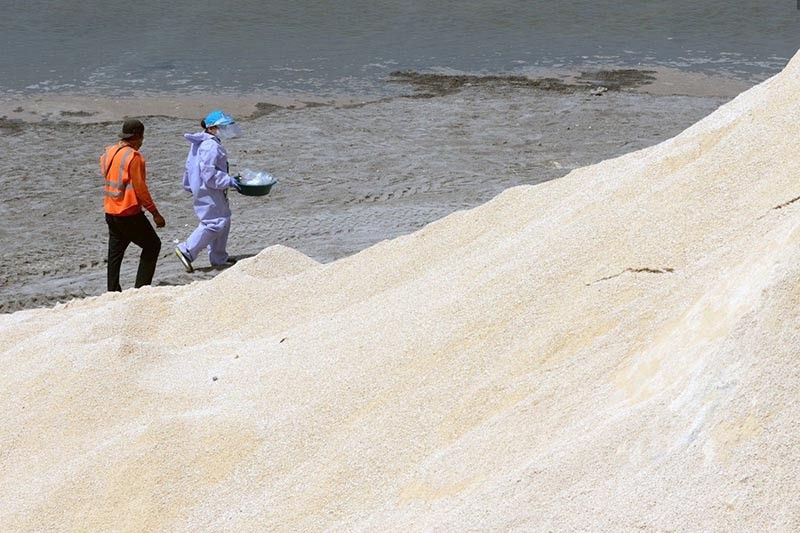No environmental impact study needed on Manila 'beach nourishment' — DENR

MANILA, Philippines (Updated 3:45 p.m.) — The project to give Manila Bay a makeover by pouring “white sand” on its shoreline does not have to go through the process of preparing an environmental impact study and obtaining a compliance certificate, the Department of Environment and Natural Resources said.
Projects in the country that may affect the environment need to go through the Environmental Impact Statement (EIS) process and get an environmental compliance certificate (ECC), environmental lawyer Gloria Estenzo-Ramos said as a response to the move of the DENR to fill Manila Bay’s naturally dark shoreline with “white sand” as part of the government’s program to rehabilitate the degraded waterway.
But DENR Undersecretary Benny Antiporda said the “beach nourishment” project is not covered by the country’s EIS system.
“It is a rehabilitation project, not a construction project. It’s only a beach nourishment [project] in which we’re beautifying it,” Antiporda told Philstar.com in a phone interview Thursday.
Antiporda, however, said the crushed dolomite boulders will not “disrupt” the coastal ecosystem.
“Kami sa DENR pinag-aralan natin ‘yan. In the first place ‘yung mga ginamit dyan, especially ‘yung sand, ‘yung dolomite boulders na ‘yan it contains calcium carbonate and if you will look sa corals, calcium carbonate din. So it will not disrupt the coastal ecosystem,” Antiporda said.
(We studied it. In the first place what we used, especially the sand, the dolomite boulders it contains calcium carbonate and if you will look at corals, it’s made up of calcium carbonate. So it will not disrupt the coastal ecosystem.)
Certificate of non-coverage
Projects or undertakings which are seen to have significant adverse impact to the quality of the environment are covered by the country’s EIS system, according to Memorandum Circular 2014-005 of the DENR-Environmental Management Bureau. These projects include “proposed major expansion, rehabilitation and/or modification of existing projects as well as resumption of projects that have stopped operations for a prolonged period.”
An environmental impact assessment evaluates the likely impacts of a project on the environment and the surrounding communities and includes mitigation and preventive measures to address the identified consequences of a project.
An ECC, meanwhile, is issued by the EMB to a project’s proponent certifying that the proposed undertaking has complied with the requirements of the EIS system and has committed to address environmental impacts.
Antiporda said the project obtained a certificate of non-coverage (CNC), which is issued to projects that are deemed unlikely to cause significant adverse impacts on the environment. This is issued by the EMB to certify that the undertaking is not covered by the EIS system and is not required to secure an ECC.
The environment official earlier said covering a stretch of the bay with “white sand” will serve as an awareness campaign to protect the environment and allow people who have never experienced the popular white sand beaches in Boracay El Nido and Bohol to have one in the capital.
But it was met with criticism from environmental and fisherfolk groups, saying it will not make Manila Bay cleaner and may even affect the natural ecosystem and coastal integrity of the waterway.
Fishers group PAMALAKAYA said a better solution is to grow mangroves and seagrass instead.
“Lahat ‘yan ginagawa natin. We’re addressing it all at the same time. Pero di mo naman pwedeng ma-comply ‘yan at all the same time,” Antiporda said, adding the department is planning to spearhead a mangrove planting project on the bay in coordination with the city government of Manila.
(We’re doing all of that. We’re addressing it all at the same time but you cannot comply everything all the same time.)
Pulverized rocks
The plan is to cover one hectare of the baywalk with “white sand” at 1-meter thick, Antiporda said.
The “white sand” was actually made of crushed dolomite boulders that were transported from Cebu province to Manila. Dolomite is a mineral composed of calcium magnesium carbonate.
When asked where the dolomite was sourced, Antiporda said this was handled by the Department of Public Works and Highways, the implementing arm of the project.
Dolomite is being mined in Brgy. Pugalo in Alcoy town, Cebu.
A notice of award issued by the Department of Public Works and Highways on Dec. 27, 2019 showed that P389.8 million was awarded to MAC Builders/Dragonhart Construction Enterprise Inc for the “beach nourishment, coastal restoration and enhancement of Manila Baywalk Area.”
The project to clean up Manila Bay—known for its amazing sunset views and garbage-strewn, murky waters—began in January last year.
- Latest
- Trending

































